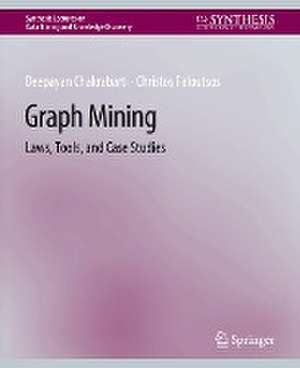Graph Mining: Laws, Tools, and Case Studies: Synthesis Lectures on Data Mining and Knowledge Discovery
Autor Deepayan Chakrabarti, Christos Faloutsosen Limba Engleză Paperback – 18 oct 2012
Din seria Synthesis Lectures on Data Mining and Knowledge Discovery
- 20%
 Preț: 180.60 lei
Preț: 180.60 lei - 20%
 Preț: 352.78 lei
Preț: 352.78 lei - 20%
 Preț: 325.73 lei
Preț: 325.73 lei - 20%
 Preț: 358.56 lei
Preț: 358.56 lei - 20%
 Preț: 354.42 lei
Preț: 354.42 lei - 20%
 Preț: 387.01 lei
Preț: 387.01 lei - 20%
 Preț: 383.89 lei
Preț: 383.89 lei - 20%
 Preț: 387.47 lei
Preț: 387.47 lei - 20%
 Preț: 168.23 lei
Preț: 168.23 lei - 20%
 Preț: 224.97 lei
Preț: 224.97 lei - 20%
 Preț: 224.00 lei
Preț: 224.00 lei - 20%
 Preț: 163.23 lei
Preț: 163.23 lei - 20%
 Preț: 222.50 lei
Preț: 222.50 lei - 20%
 Preț: 229.12 lei
Preț: 229.12 lei - 20%
 Preț: 298.52 lei
Preț: 298.52 lei - 20%
 Preț: 199.72 lei
Preț: 199.72 lei - 20%
 Preț: 165.44 lei
Preț: 165.44 lei - 20%
 Preț: 177.98 lei
Preț: 177.98 lei - 20%
 Preț: 327.62 lei
Preț: 327.62 lei - 20%
 Preț: 384.03 lei
Preț: 384.03 lei -
 Preț: 399.13 lei
Preț: 399.13 lei
Preț: 229.59 lei
Preț vechi: 286.99 lei
-20% Nou
Puncte Express: 344
Preț estimativ în valută:
43.93€ • 45.78$ • 36.38£
43.93€ • 45.78$ • 36.38£
Carte tipărită la comandă
Livrare economică 03-17 aprilie
Preluare comenzi: 021 569.72.76
Specificații
ISBN-13: 9783031007750
ISBN-10: 3031007751
Pagini: 191
Ilustrații: XVI, 191 p.
Dimensiuni: 191 x 235 mm
Greutate: 0.37 kg
Editura: Springer International Publishing
Colecția Springer
Seria Synthesis Lectures on Data Mining and Knowledge Discovery
Locul publicării:Cham, Switzerland
ISBN-10: 3031007751
Pagini: 191
Ilustrații: XVI, 191 p.
Dimensiuni: 191 x 235 mm
Greutate: 0.37 kg
Editura: Springer International Publishing
Colecția Springer
Seria Synthesis Lectures on Data Mining and Knowledge Discovery
Locul publicării:Cham, Switzerland
Cuprins
Introduction.- Patterns in Static Graphs.- Patterns in Evolving Graphs.- Patterns in Weighted Graphs.- Discussion: The Structure of Specific Graphs.- Discussion: Power Laws and Deviations.- Summary of Patterns.- Graph Generators.- Preferential Attachment and Variants.- Incorporating Geographical Information.- The RMat.- Graph Generation by Kronecker Multiplication.- Summary and Practitioner's Guide.- SVD, Random Walks, and Tensors.- Tensors.- Community Detection.- Influence/Virus Propagation and Immunization.- Case Studies.- Social Networks.- Other Related Work.- Conclusions.
Notă biografică
Dr. Deepayan Chakrabarti obtained his Ph.D. from Carnegie Mellon University in 2005. He was a Senior Research Scientist with Yahoo, and now with Facebook Inc. He has published over 35 refereed articles and is the co-inventor of the RMat graph generator (the basis of the graph500 supercomputer benchmark). He is the co-inventor in over 20 patents (issued or pending). He has given tutorials in CIKM and KDD, and his interests include graph mining, computational advertising, and web search. Christos Faloutsos is a Professor at Carnegie Mellon University and an ACM Fellow. He has received the Research Contributions Award in ICDM 2006, the SIGKDD Innovations Award (2010), 18 "best paper" awards (including two "test of time" awards), and four teaching awards. He has published over 200 refereed articles, and has given over 30 tutorials. His research interests include data mining for graphs and streams, fractals, and self-similarity, database performance, and indexing for multimedia and bio-informatics data.
